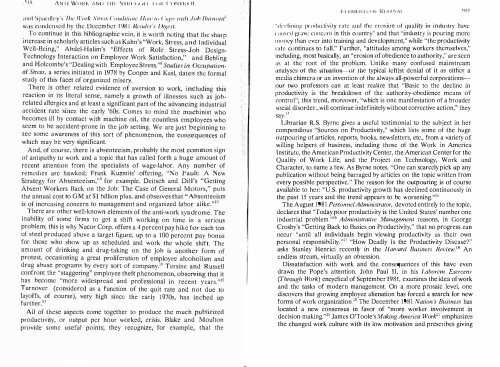CONTENTS - ouroboros ponderosa
CONTENTS - ouroboros ponderosa
CONTENTS - ouroboros ponderosa
You also want an ePaper? Increase the reach of your titles
YUMPU automatically turns print PDFs into web optimized ePapers that Google loves.
. " IS AN IJ Wi tH .... :\ NJ ) 1111· Sll{l ll doi I 1111\ ('/lNII.:, )1<br />
alld Spanlh-y's 'Ilw '·Vork .''In',,s ('O/ldition: 1/1111' 10 ( ' (III{' 11';1/, ./0" lJunlOlilJ<br />
was condensed by the December ('IX ( IInu/,.,.\, /liM/'st.<br />
.<br />
To continue in this bibliographic vein, it is worth noting that the sharp<br />
lllcrease In scholarly articles such as Kahn's "Work, Stress, and Individual<br />
Well-Being," Abdel-Halim's "Effects of Role Stress-Job Design<br />
Technology Interaction on Employee Work Satisfaction," and Behling<br />
and Holcombe's "Dealing with Employee Stress.'" Studies in Occupation<br />
al Stress, a series initiated in 1978 by Cooper and Kasl, dates the formal<br />
study of tbis facet of organized misery,<br />
Th re is other related evidence of aversion to work, including this<br />
reactIon In Its hteral sense, namely a growth of illnesses such as job<br />
related allerglcs and at least a significant part of thc advancing industrial<br />
aCCIdent rate Slllce thc early '60s. Comes to mind the machinist who<br />
becomes ill by contact with machine oil, the countless cmployees who<br />
seem to be accident-prone in the job setting. We are just beginning to<br />
see some awareness of this sort of phenomenon, the consequences of<br />
whIch may be very significant.<br />
And, of coursc, there is absenteeism, probably the most com mon sign<br />
of antIpathy to work and a topic that has called forth a huge amount of<br />
recenr. attentIon from the specialists of wage-labor. Any number of<br />
remed,es arc hawked; Frank Kuzmits' offering, "No Fault: A New<br />
Strategy for Absenteeism,'" for example. Deitsch and DiU's "Getting<br />
Absent Workers Back on the Job: The Case of General Motors," puts<br />
the annual cost to GM at $1 billion plus, and observes that "Absenteeism<br />
is of increasing concern to management and organized labor alike."IO<br />
. There are other v.:ell-known elements of the anti-work syndrome. The<br />
Iflab,hty of some f, rms to get a shift working on time is a serious<br />
problem; this is why Nucor Corp. offers a 4 percent pay hike for each ton<br />
01 steel produced above a target figure, up to a 100 percent pay bonus<br />
for those who show up as scheduled and work the whole shift. The<br />
amount of drinking and drug-taking on the job is another form of<br />
protest, occasioning a great prolifcration of employee alcoholism and<br />
drug abuse programs by cvery sort of company." Tersine and Russell<br />
confront the "staggering" employee theft phenomenon, observing that it<br />
has become "more widespread and professional in recent years. ,,12<br />
Turnover (considered as a function of the quit rate and not due to<br />
layoffs, of course), very high since the early 1970s has inched up<br />
further.13<br />
All of these aspects come together to produce the much publicized<br />
productIVIty, or output per hour worked, crisis. Blake and Moulton<br />
provide somc useful points; they recognize, for example, that the<br />
.<br />
'<br />
<<br />
,<br />
'i :,<br />
'ii -<br />
.. "<br />
•<br />
""('dillillg produclivity rate and Ihe erosion of quality in indu:-itry have<br />
calJsl'd grave cOl1ct.:rn in this country" and that ""industry i pouring more<br />
"It lIlt'Y t han ever into training and development," while "the productivity<br />
rate continues to fall." Further, "attitudes among workers themselves,"<br />
including, most basically, an "erosion of obedience to authority," are seen<br />
as at the root of the problem. Unlike many confused mainstream<br />
analyses of the situation---or the typical leftist denial of it as either a<br />
media chimera or an invention of the always all-powerful corporations<br />
our two professors can at least realize that "Basic to the decline in<br />
productivity is the breakdown of the authority-obedience means of<br />
control"; this trend, moreover, "which is one manifestation of a broader<br />
social disorder...will continue indefinitely without corrective action," they<br />
say,l11<br />
Librarian R.S. Byrne gives a useful testimonial to the subject in her<br />
compendious "Sources on Productivity," which lists some of the huge<br />
outpouring of articles, reports, books, newsletters, etc., from a variety of<br />
willing helpers of business, including those of the Work in America<br />
Institute, the American Productivity Center, the American Center for the<br />
Quality of Work Life, and the Project on Technology, Work and<br />
Character, to name a few. As Byrne notes, "One can scarcely pick up any<br />
publication without being barraged by articles on the topic written from<br />
every possible perspectivc." The reason for the outpouring is of course<br />
available to her: "U.S. productivity growth has declined continuously in<br />
the past 15 years and the trend appears to be worsening.""<br />
The August 1981 Personnel Administrator, devoted entirely to the topic,<br />
declares that "Today poor productivity is the United States' number one<br />
industrial problem ,, 16 Administrative Management reasons, in George<br />
Crosby's "Getting Back to Basics on Productivity," that no progress can<br />
occur "until all individuals begin viewing productivity as their own<br />
personal responsibility,, , l7 "How Deadly Is the Productivity Disease?"<br />
asks Stanley Henrici rccently in the I1arvard Business Review.18 An<br />
endless stream, virtually an obsession.<br />
Dissatisfaction with work and the 'consequences of this have even<br />
drawn the Pope's attention. John Paul II, in his Jaborem Exercens<br />
(Through Work) encyclical of September 1981, examines the idea of 1V0rk<br />
and the tasks of modern management. On a more prosaic level, one<br />
discovers that growing employee alienation has forced a search for new<br />
forms of work organization 19 The December 1981 Nation '.I Business has<br />
located a new consensus in favor of "more worker involvement in<br />
decision-making."zo James O'Toole's Making America Work" emphasizes<br />
the changed work culture with its low motivation and prescribes giving






